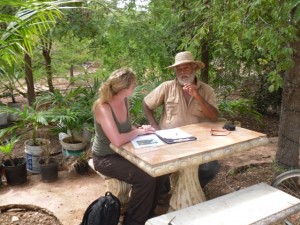I was intending to tell you more about the project back in May but the fact I haven’t done so until now kind of tells you a lot about the project. If you will allow me to do so now then I’ll try and tell you what we got up to this year.
We, the parrot team were a fellowship of five. The un-stopable Rhian Evans was co-ordinating and leading the fieldwork, Jose Antonio Diaz was our 120% percent “eternal life to the parrots” volunteer (see his parrots.org blog), the first of our two Masters students was the ever so charming Matt Richards who brought a new level of class and grammatical correctness to the project, the second student, and second only because of the reverse alphabetical order, was Danni Parks who used a thick veil of dizzy blonde-ness to hide her supreme organizational and dedicated researcher talent, last but I’d like to believe not least was me!
The season began as it always does with orientating the group, training and nest finding. Bonaire is a small boomerang shaped island and so, unlike the North Yorkshire coast, the sea is not always to the east. That can really throw people’s navigation off course in their early days, even if they are not fortunate enough to come from North Yorkshire. Thankfully even here in Bonaire the sun does always rise in the east and correspondingly sets in the west, so that helps. Nest finding is generally the team’s first experience of bashing through Bonaire’s thorny woodland and unlike navigation there’s no cunning other solution. You have to just deal with the heat, the puncture wounds and steep hills. The payback is that you might get to find a new nest, which is an incredible feeling. This year we found several new nests and many of the old faithful pairs used their same nests again too. In total we monitored 25 nests, which is a little less than in other years. Those pairs laid 76 eggs, 4 were predated or damaged, but 24 were infertile or didn’t hatch. So 48 chicks did hatch and of those 15 chicks fledged. You’ll notice that’s quite a dramatic reduction in numbers as the season goes on but that fairly typical.
The parrot season can be all consuming but in addition to gaining parrot monitoring experience and contributing to the project Matt and Danni had their own projects to conduct. Matt was investigating the environmental conditions in nest sites and whether that influenced nest success. A remarkably high number of parrot eggs fail to hatch. Some are predated or damaged but of those that are viable at the end of incubation only about 70% hatch. This year it actually dropped to 66%. Matt did not however find any correlation between the environmental conditions and this measure which is called Hatchability. Poor Matt was a bit deflated to not get a significant result but of course very much still an important insight and in fact in this case it is way more interesting. If it is not the environmental conditions inside nests that is influencing hatchability there is a very good chance that it could be due to inbreeding depression. This population genetics issue is very interesting and something we will have to try and look at in greater detail.

Danni investigated the important conservation issue of parrot/human conflict. The impact of humans and more recently introduced goats and donkeys on Bonaire’s habitat has been profound. Although much wilderness exists the diversity of plant species is low and consequently there are seasonal shortage of food for the growing parrot population. In these periods the parrots come into urban areas and feed on people’s fruit tress. Being the early risers that they are, more than a little bit noisy and uninvited, the parrots do not endear themselves to fruit growers. Most of all though, the thing that really really upsets people is that the parrots might take one bite of a mango and then drop it. I’ve had people going red in the face when they tell me how wasteful the parrots are. Danni looked at poeples perceptions, the impact of parrots and then tested whether it was possible to use bird of prey shaped kites to keep them away. People’s perceptions were pretty much bang on, there is no getting around it the parrots do cause some damage. Some people didn’t mind and said that they couldn’t collect or eat all those mangos anyway but 55% either disliked or strongly disliked the parrots. What was really interesting, considering the amount of awareness work that goes on from the various groups here on Bonaire was that 45% of people didn’t actually know the parrot was endangered. We’re going to look into that some more soon. The idea with the kites was that they replicate the sihouete of a bird of prey and they dance on the constant trade winds. Just as we humans have an innate fear of snakes, parrots have an innate fear of raptors and so the idea was they would fear the kites and when they saw one of the islands birds of prey for real it would re-inforce that fear. It’s all good in theory but as Danni found out parrots are pretty smart and in a nutshell, the kites didn’t work. So the quest for a solution continues…

I’ve still got so much tell you but if I write anymore you’ll need a spare lifetime to get through this blog so rather than that I will save it for next time. And worry not dear reader in a slightly mis-timed New Years resolution I have decided not only to eat fewer biscuits but also to blog more. There really is so much amazing stuff happening here on Bonaire and it is a disservice not to share it with you. What’s more, very soon I will even post something about parrots once again.
































